Menus
- For the country roads of the world
- The engine pounds away
- Wonderfully balanced despite 370 kilograms
- The drive is designed for an optimal torque curve
- The Indian Chieftain convinces with gimmicks
- Chieftain suspension irons out almost everything

Manufacturer
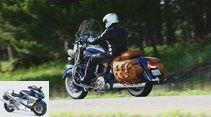
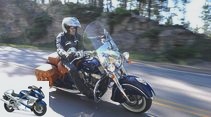

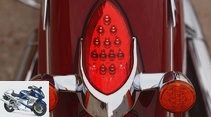
30th photos

Indian
1/30
The new Indian models for 2014 were allowed to be tested exclusively by journalists from all over the world.
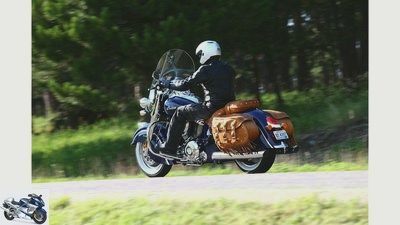
Indian
2/30
The leather suitcases with a fringed look at Vintage may not be for everyone.
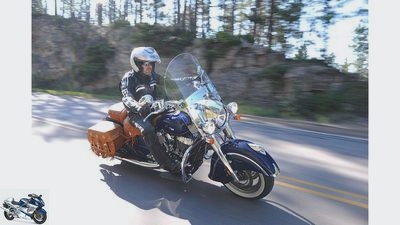
Indian
3/30
Out and about on the Chief Vintage.
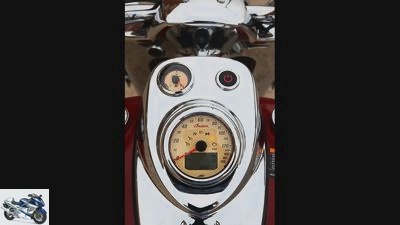
Indian
4/30
Beautifully solved: classic scale and fuel gauge. The digital display provides more information.
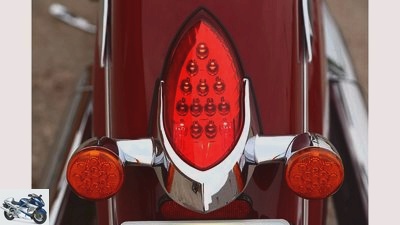
Indian
5/30
Modern meets classic – LEDs work in the rear light and indicators.
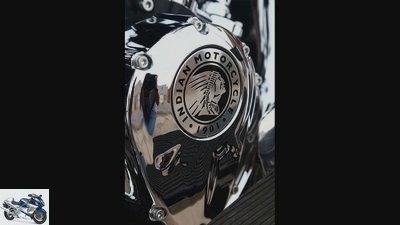
Indian
6/30
The manufacturer’s emblem can be found more often on the machines.

Indian
7/30
The Classic is equipped with an air-cooled two-cylinder four-stroke engine.
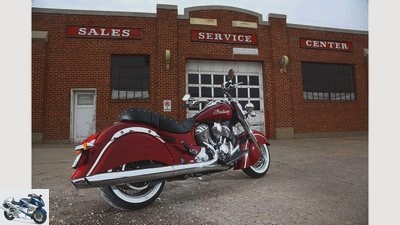
Indian
8/30
The base model on which the Vintage is built is usually supplied without a windshield.
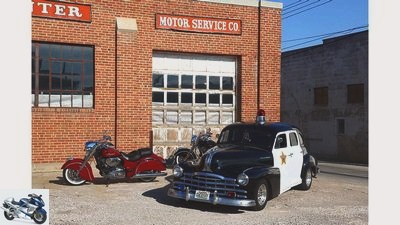
Indian
9/30
The design of the new model was until recently one of the industry’s best kept secrets.
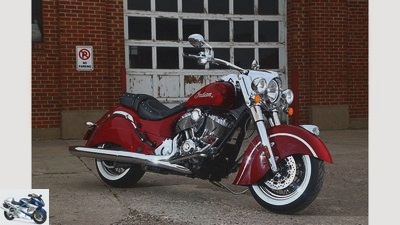
Indian
10/30
Here the new Indian Chief Classic.
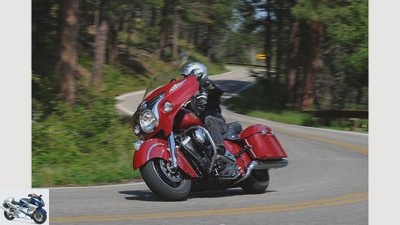
Indian
11/30
In addition, the chassis is more comfortable.
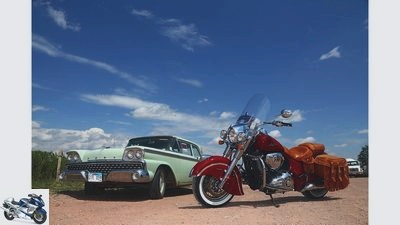
Indian
12/30
And here the vintage version in all its glory.
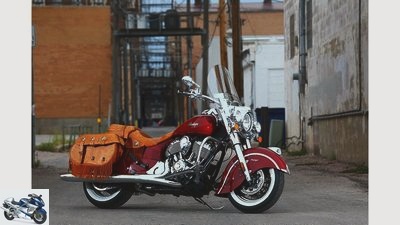
Indian
13/30
Confidence is required. The waving fringes could possibly lead to jokes.
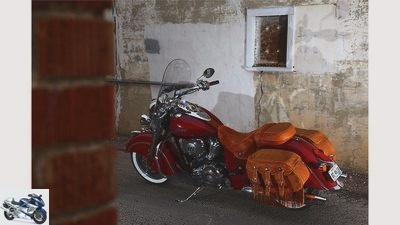
Indian
14/30
Despite everything, it is a feast for the eyes. In contrast to the Classic, the windshield is included.

Indian
15/30
Thought of everything: You can even find the Indian lettering on the handlebar ends.
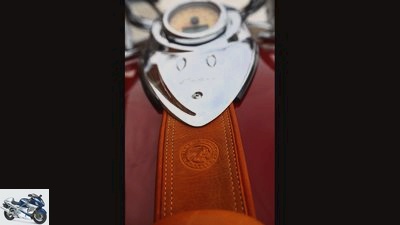
Indian
16/30
Branding: The logo is emblazoned everywhere – here for example on the tank leather.

Indian
17/30
The engine of the Chieftain.
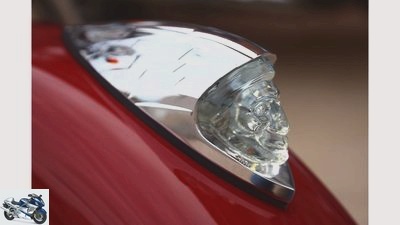
Indian
18/30
As nostalgic as it used to be: The Indian head on the front fender is illuminated today.
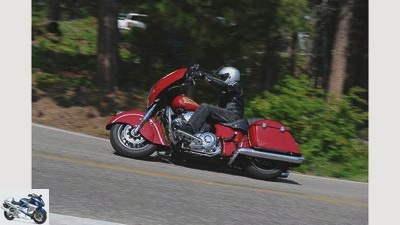
Indian
19/30
And with it: The Chieftain can be wagged more easily through curves – its wheelbase is shorter and the steering head angle is steeper.
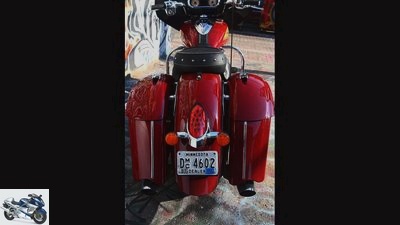
Indian
20/30
The Chieftain is incredibly comfortable.

Indian
21/30
You should definitely see it in real life: The newly developed engine is a feast for the eyes.
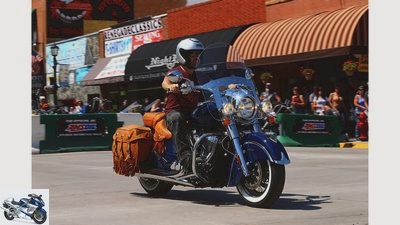
Indian
22/30
It cuts a fine figure both on country roads and in the city.
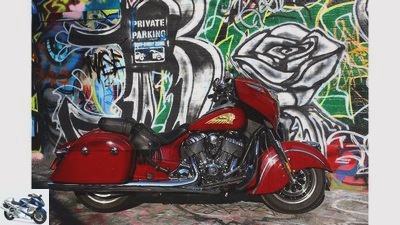
Indian
23/30
The Chieftain gets along completely without any leather frills.
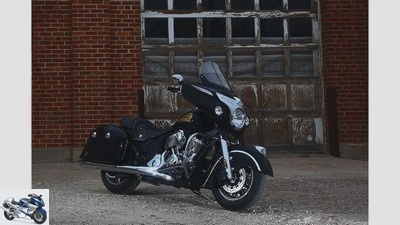
Indian
24/30
The Chieftain is also available in black.
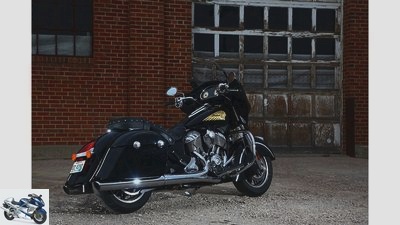
Indian
25/30
The front part is significantly wider than that of the Chief Classic and Vintage.
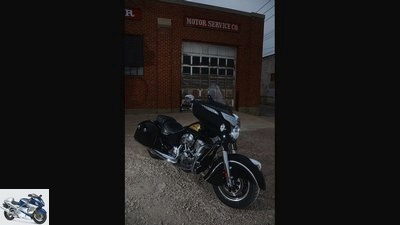
Indian
26/30
Above all, it scores with its gimmicks such as the electrically adjustable paneling.
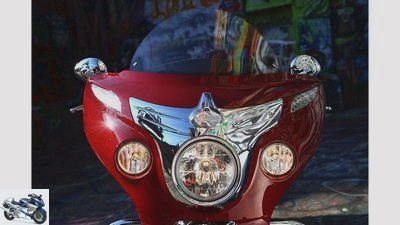
Indian
27/30
Here is the fixed front panel of the Chieftain.
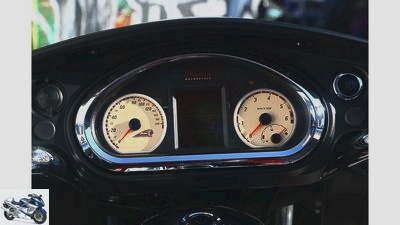
Indian
28/30
Clear and absolutely informative: the Chieftain’s cockpit leaves nothing out.
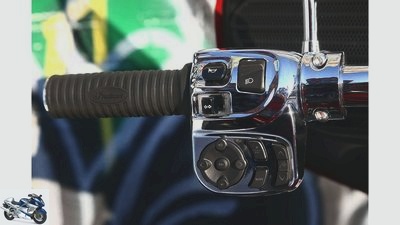
Indian
29/30
Long fingers are required for the controls of the stereo sound system.
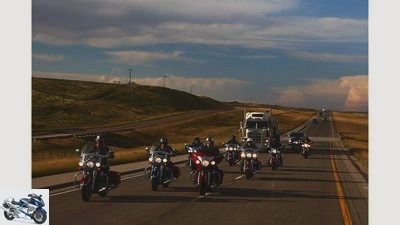
Indian
30/30
The loud sound doesn’t bother anyone on the American streets through the pampas.
Indian models 2014 in the driving report
For the country roads of the world
Looking at the new Indian models, questions arise: How much Harley can Indian do? Or maybe Indian can even do better than Harley? MOTORRAD followed the smoke signals and has already driven. You can read the answers here.
Damn it! Where is the key here? And where is the ignition switch? My bottom tester rests in the thick-leather comfort saddle of the I.ndian Chief Vintage, and we’re about to go on tour. 1000 kilometers across the American Midwest. Desperate looks over the cockpit. I feel like the rest of the huge crowd of journalists who have traveled from all over the world to get to know the brand new Indian models. Gary Gray, responsible for the development of motorcycles, explains: It is started without a key. Simply press the round button on the chrome console and then press the starter button – that’s it.
Buy complete article
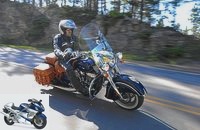
Indian models 2014 in the driving report
For the country roads of the world
Anticipation, expectations, devotion
There are only maybe four seconds between my hand movement to the two buttons and the first turn of the crankshaft, no more. These are flooded with anticipation, expectations and devotion. Because only a few days ago the new Indian models were presented to the global public at this year’s motorcycle rally in Sturgis, a mega event that attracts up to 450,000 motorcyclists. Basically there are two models: the Chieftain, a tourer with a sweeping fairing and plastic cases. And the Chief Classic, which is also available in a special vintage version with a windshield and brown leather bags. Fans all over the world knew in advance what the engine would look like. However, the design of the vehicles was until recently one of the best-kept secrets in recent motorcycle history.
The engine pounds away
Push of a button. Boller, boller, boller. The engine pounds away without causing a stir. Doesn’t wriggle as vigorously as some Harley engines do, however. The unit was developed at Swissauto in Switzerland, a company that Polaris bought practically in passing. The 1811 cubic Vau produces a powerful massaging pulsation. You can tell immediately that there is no underpowered rogue at work here. It wouldn’t be surprising if a 500 cc single-cylinder acted as a starter somewhere down there. The V2 hums with only 750 revs in idle. Softer than comparable Harley engines and mechanically much quieter.
Involuntarily, the question arises how this works with an air-cooled drive in which – as with Harley – bumpers take over the control of the two valves per cylinder. And of course one wonders why a powerful company like Polaris is embarking on a journey into the future with an air-cooled engine. A future in which stricter emission values will apply, which will even force Harley to equip their engines with water cooling. You ask so many questions, but all Gary Gray has to say is, “I don’t see any need to cool this engine with water for the next 20 years. It’s beautiful and easily meets the upcoming emission limits. ”Amen.
Wonderfully balanced despite 370 kilograms
Gear in. Of course, with such a Bollermann von Motor, one shouldn’t expect this process to feel as if precision mechanical parts are being wedded together. No it rocks. The feedback when changing gears is full. Everything about the unit, which the Polaris boys named Thunder Stroke 111, is comparatively huge. It starts with the lush cooling fins, culminates in a massive 163 Newton meters of torque output and ends with a clutch with a large diameter. Which, by the way, can be operated with relatively little effort and wonderfully dosed.
You can feel the weight as soon as you roll away, your feet are resting on well-placed running boards. The manufacturer specifies 370 kilograms for the Chief Vintage. Not just a little. But the machine is wonderfully balanced, once in motion it runs confidently over the interstate like a mighty old American road cruiser. It’s a shame that the Europeans will muzzle the bassy sounding silencers. In the vastness of the Midwest, the rumble doesn’t bother anyone. And it’s really a rumble when you open the throttle valves, which, by the way, are controlled by drive-by-wire. “We used all possible tricks to make the engine mechanically quiet so that the entire sound output comes from the silencers,” Gary Gray will say later.
The technical tricks that he means primarily relate to quite massive engine housing walls that contain the noise. The crankshaft sends the power via a gear pair directly to the clutch, which, as is common on most bikes, sits on the gearbox input shaft. Rattling chains, such as those used by Harley, for example, between the crankshaft and clutch and in the transmission drive to the separate gearbox, are no longer required at Indian. The Thunder Stroke 111 turned out to be extremely compact. Extremely calm. And extremely powerful.
The drive is designed for an optimal torque curve
Open Road. Solid yellow center lines. Free travel to the horizon. Time for gas games. No matter which of the six gears you have engaged, and no matter what speed the wonderfully scaled speedometer is currently showing – nothing jerks when you pull the gas. Even at 1200 rpm, the engine pushes forward gently without complaining. But it lets you feel exactly which speeds it loves: Emotionally, the Vau produces its maximum torque between 2500 and 4000 rpm. The engine feels most at home in this area, and above it it acts rather sluggishly. In sixth gear, that means speeds between 80 and 160 km / h. The maximum output of 92 hp only peaks at 5300 rpm, but that is not achieved in sixth gear. You only get these speeds in fifth gear, because sixth is an overdrive. Too much theory? Let’s put it this way: The top speed of 183 km / h homologated for Europe is completely irrelevant. This drive is designed for an optimal torque curve. And that is chosen so that you can move the new Indians perfectly and powerfully on the country roads of this world. Low-speed. Medium speed. Great emotions. Good vibrations.
In general, vibrations: Polaris gave the Thunder Stroke 111 just the right mix of vibrations. The engine doesn’t feel nearly as synthetic as the Victory V2 engines made in-house, but also not as mechanically rough as large Harley Big Twins. A balance shaft driven by gears prevents the tremors and chattering of teeth.
The Indian Chieftain convinces with gimmicks
Indian
As nostalgic as it used to be: The Indian head on the front fender is illuminated today.
Anyone who orders the Indian Chief Classic in Germany may need a bit more self-confidence. The waving leather fringes are sure to cause nuisance at one or the other ice cream parlor.
The Chieftain does not have any fringes. She is the top model from Indian. While the engine is absolutely identical to that of the Chief, the Chieftain shows off more luxurious features: the windshield is electrically adjustable, and a gigantic sound system – 100 watts each for the front and rear – sets new standards. And electronic helpers provide precise information about the oil level, tire pressure, battery voltage or remaining range. More is almost impossible.
After 500 kilometers in the saddle of the Chief, I can change to the Chieftain. The different steering behavior is immediately noticeable. Compared to the Chief, the steering head is steeper here, and to compensate for this, the air-assisted shock absorber is also a bit longer. These measures shorten the wheelbase from 1730 to 1668 millimeters and increase the seat height from 660 to 675 millimeters. Which is still nice and low. Even those with short legs like me can still stand securely with my 1.68 meters. The steering angle is also slightly larger on the top model. One could describe the difference as follows: The Chieftain looks more manageable despite its slightly higher weight. However, the steering forces on the Chief are lower, as it does not carry a heavy fairing plus electrically adjustable window.
Chieftain suspension irons out almost everything
Indian
And with it: The Chieftain can be wagged more easily through curves – its wheelbase is shorter and the steering head angle is steeper.
At some point it comes as it has to: the tour guide gets lost mercilessly, and the whole entourage ends up on a road that would have deserved the rating of acceptable 200 years ago. It is surprising how clean the suspension of the Chieftain responds – almost everything ironed away – and spoiled with very good comfort. The tuning of the air-assisted shock absorber can be adjusted to the load condition with a few additional bars. The air cushion in the shock absorber, generated by hand using a pump (in the vehicle tool kit), creates progressiveness during compression. However, if you are only traveling alone, you can do without this step: the chassis setup is designed for a load of up to 100 kilograms without any air support.
When a couple of deer jump across the street at the end of the street, the ABS supplied by Bosch also impresses with its sensitive control behavior. The braking effect is very good. Although the brake controls could use a more precise pressure point, denouncing this would be complaints at a high level. At the end of the two-day tour, which led 1200 kilometers through the American Midwest, one wonders two things: First, why did the Indian engineers not give their vehicles traction control? If you accelerate too hard when it rains, you immediately stand across. Second, the question is whether Harley will rise to this challenge. Because the smoke signals on the horizon are a clear declaration of war. The new Indians go their own way and don’t follow the well-trodden paths of Harleys. It would not be surprising if many would follow this path.
Related articles
-
Indian Scout, Indian Roadmaster and Victory Magnum in the driving report
Indian 13 photos Indian 1/13 Just a year ago, the Polaris group presented its two Indian models, the Chief and the Chieftain. After buying the company…
-
Indian Chief and Indian Chieftain in the driving report
Cathcart 26th photos Wing 1/26 We took a closer look at the new Chief and Chieftain models from the oldest US motorcycle manufacturer Indian. Wing 2/26…
-
Driving report new Harley Softail models
Driving report new Harley Softail models A heart for softies Harley goes future: with two balance shafts and a handful of other plasticizers. Fat Boy,…
-
Indian Chief 2000 driving report
Indian Chief 2000 driving report Necromancy The longer the shadows of the past, the harder it is to start over. Indian dared anyway? and preserves old…
-
Indian Scout Bobber in the driving report
Indian 25th photos Indian 1/25 Indian Scout Bobber. Indian 2/25 Indian Scout Bobber. Indian 3/25 Indian Scout Bobber. Indian 4/25 Indian Scout Bobber….
-
Harley-Davidson models 2016 in the driving report
Harley-Davidson 22nd photos Harley-Davidson 1/22 The new Softail top models Fat Boy Special and Softail Slim Special offer more steam in the boiler…
-
Driving report Harley models 2007
Buenos dias Driving report Harley models 2007 A bigger bang Harley-Davidson is retiring the Twin Cam 88. In 2007 the Americans ignited a new evolutionary…
-
Driving report Harley-Davidson models 2008
Harley-Davidson Driving report Harley-Davidson models 2008 Heavy Birthday For its 105th birthday, the traditional American brand is by no means just…
-
Kawasaki Z 650 in the driving report
Kawasaki 9 pictures Kawasaki 1/9 picture gallery: Kawasaki Z 650 in the driving report. Kawasaki 2/9 The diet worked: Compared to the ER-6n, the Z 650 has …
-
Driving report Victory models 2016
Blacksmith 23 photos Blacksmith 1/23 What’s up in Victory’s future? With a whole range of measures, Victory is positioning itself as a sportier US brand…